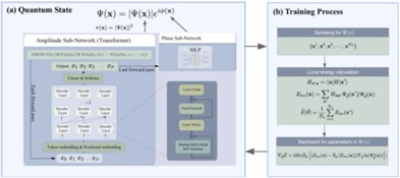Weekly Advanced Technologies〔90〕

Weekly Advanced Technologies〔90〕丨Bioinspired Spine Metamaterial Achieves Stiffness-Tuning and Real-Time Optical Data Readout; "QiankunNet" Unleashes Exact Solutions for Many-Electron Schrödinger Equations
Traditional mechanical information storage faces challenges in readability and modifiability. However, a newly developed spine-inspired smart material offers a breakthrough: it can adjust its stiffness to store information and emit light for display, bringing new hope for information processing in extreme environments. Meanwhile, solving the "fundamental equations" of the quantum world has long been hindered by the computational explosion problem. To address this, a team from the University of Science and Technology of China has integrated AI with quantum physics to develop a novel model that efficiently and precisely simulates multi-electron systems, providing a powerful tool for materials and chemical research.
Based on the weekly diary of technology provided by the daily list of the NCSTI online service platform, we launch the column "Weekly Advanced Technologies" at the hotlist of sci-tech innovation. Today, let's check out No.90.
1. Science Advances丨Bioinspired Spine Metamaterial Achieves Stiffness-Tuning and Real-Time Optical Data Readout

Magnetorheological Mechanical Computing Metamaterial
Current mechanical information processing methods face limitations in achieving high-density, reprogrammable, and visually interpretable functionalities, which restricts the application potential of mechanical information systems in extreme environments. Consequently, there is an urgent need to develop mechanical metamaterials that simultaneously possess high encoding density, reconfigurability, and visual readout capabilities.
Professors GONG Xinglong and DENG Huaxia from the University of Science and Technology of China have made progress in the design of mechanical metamaterials. Their study draws inspiration from the structure and function of the human spine, constructing a stiffness reprogrammable magnetorheological metamaterial (SRMM).
The research reveals that the magnetorheological spinal beam achieves stiffness variation through magnetically controlled bistable transition, which serves as the key mechanism for high-density information encoding. Based on this principle, the team has integrated mechanoluminescent materials, enabling real-time visual readout of information states via mechanical-to-optical energy conversion.
The SRMM exhibits broad information-encoding potential and stable operational performance, providing a convenient optical readout method. This breakthrough offers a new pathway for designing mechanical information-processing systems in extreme environments.
2. Nature Communications丨"QiankunNet" Unleashes Exact Solutions for Many-Electron Schrödinger Equations

QiankunNet
Team of Special-Term Professor SHANG Honghui from University of Science and Technology of China and Academician YANG Jinlong of Chinese Academy of Sciences has integrated the Transformer architecture from artificial intelligence with quantum physics, proposing a novel method named "QiankunNet" for accurately solving the many-electron Schrödinger equation. This equation serves as the theoretical foundation for predicting material and molecular properties, but its computational complexity grows exponentially with the number of electrons, making traditional methods inadequate for complex systems.
QiankunNet innovatively incorporates the "attention mechanism" from Transformers to effectively capture intricate electron-electron correlations and construct high-accuracy quantum wavefunctions. The network employs an end-to-end differentiable architecture (end-to-end differentiable architecture), directly optimizing energy through backpropagation while integrating physics-inspired initialization strategies to accelerate convergence. The team also designed an autoregressive sampling algorithm incorporating Monte Carlo tree search, enabling parallel generation of independent electronic configurations. This significantly improves sampling efficiency and stability, overcoming the limitations of traditional methods such as strong sample correlations and slow convergence.
In tests, QiankunNet achieved 99.9% accuracy in correlation energy calculations compared to full configuration interaction for molecular systems with up to 30 spin orbitals. It outperformed traditional coupled cluster methods in addressing strong correlation problems like chemical bond breaking, delivering both higher speed and precision. The research team further applied it to simulate the Fenton reaction—a key process in biological oxidation—successfully modeling the complete O-O bond cleavage in iron-containing complexes. The method precisely characterized electronic structure changes during iron ion oxidation, demonstrating strong potential for complex transition-metal systems. This work provides an efficient new tool for accurately simulating real chemical systems.
3. Nature Photonics丨Nanoscale Light Emitters with Ultrahigh Brightness Visualize Intracellular Dynamics

Vitrification-Prepared suPdots
The research team led by WANG Jianjun at the Technical Institute of Physics and Chemistry, Chinese Academy of Sciences, in collaboration with the team led by Xiaohong Fang at the Hangzhou Institute for Advanced Study, University of Chinese Academy of Sciences, has innovatively proposed a "cryo-assembly" strategy based on their understanding of ice crystal nucleation and growth mechanisms. The research team successfully developed single-chain ultrasmall fluorescent polymer dots (suPdots), with sizes below 5 nanometers from single organic fluorescent polymer chains. These novel probes combine high brightness, superior photostability, well-defined composition, precisely modifiable surfaces, and tunable fluorescence, providing an ideal tool for achieving high spatiotemporal resolution in monitoring biomolecular dynamics.
The suPdots demonstrate significant performance advantages: Firstly, employing commercially available conjugated polymers enables spectral coverage across the entire visible range, ensuring wide applicability. Secondly, single-particle brightness reaches ~15-fold higher intensity than green fluorescent protein (GFP), with distinct optical properties exhibited by different structures, allowing customizable selection. Thirdly, precise surface modulation can be achieved through functional group modifications. When conjugated with antibodies, they enable high-specificity, high-density labeling of subcellular structures. Their ultrasmall size (<5 nm) causes minimal disruption to biomolecules' native physiological behaviors.
In application, the research team utilized suPdots combined with stimulated emission depletion (STED) super-resolution microscopy, revealing the hollow ring-shaped architecture of clathrin-coated pits. Furthermore, leveraging their exceptional brightness and ultrasmall dimensions, the team achieved real-time tracking of single kinesin motor stepping motions in live cells using only conventional confocal microscopy – attaining 50-Hz frame rates and ~8-nm localization precision. This breakthrough has accomplished single-molecule observations without relying on expensive MINFLUX instruments, demonstrating suPdots' immense potential for advancing single-molecule biological studies.